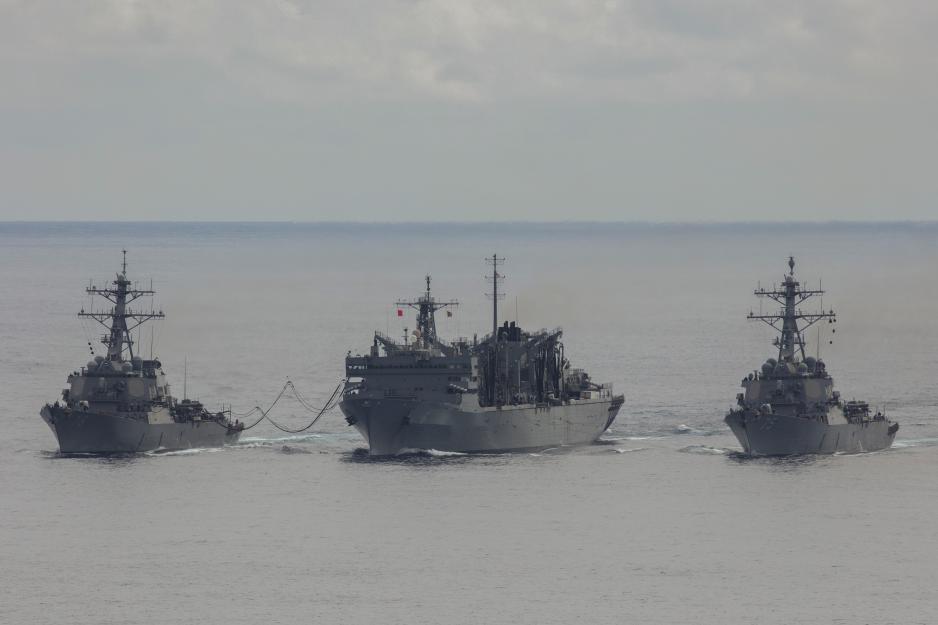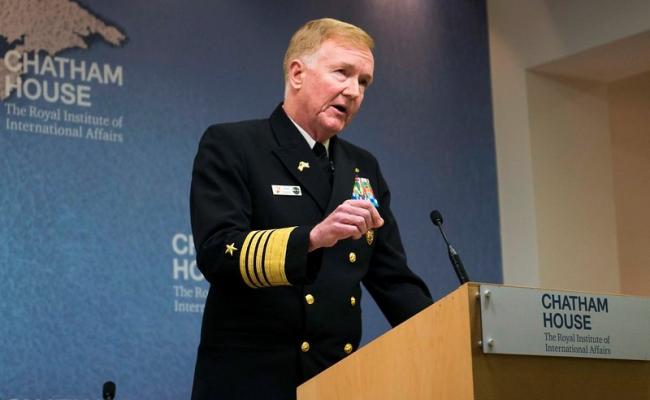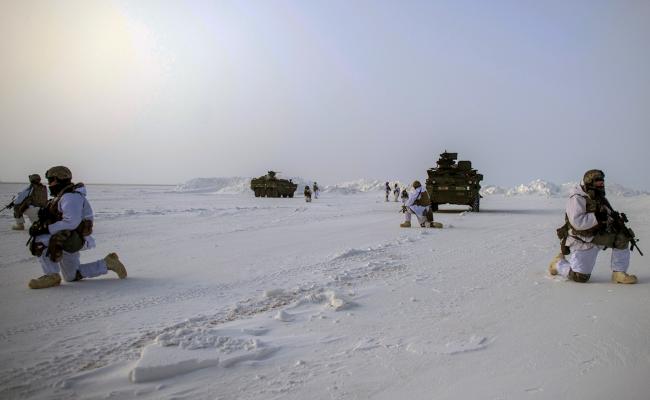Chinese Activity Increases in the High North: No Sign of Military Presence, Says IFS Researcher

The USS Donald Cook, USSS Porter and USNS Supply during a British-American exercise in the Barents Sea in April/May. Despite recent American statements, professor Øystein Tunsjø at the Norwegian Institute for Defence Studies sees no sign of Chinese military operations in the High North. Photo: Dan Rosenbaum/Royal Navy
Warnings about increased Russian and Chinese activity in the Arctic recently resurfaced in America. Professor Øystein Tunsjø at the Norwegian Institute for Defence Studies says to High North News that there is a general increase of activity in the region; however, he sees no signs that the Chinese have military operations in the High North.
“The Chinese and the Russians are everywhere, especially the Chinese. You would be alarmed at the amount of Chinese activity off the coast of Norway in the High North. And we need to be vigilant to that. We need to understand why», former US Ambassador to Norway Kenneth J. Braithwaite said in a hearing earlier this month related to his confirmation hearing to become Secretary of the Navy.
The Commander of the United States Naval Forces Europe and Africa, Admiral James G. Foggo III, also recently warned that everyone should be aware of Russian activities, claiming Russia has “taken an aggressive approach in the Arctic”.
These statements add to a series of US warnings in recent years regarding Russian and Chinese activity in the Arctic. The emphasis on Chinese activities in the region are preeminent.
“Do we want the Arctic to be transformed into a new South China Sea, with increased militarization and competing territorial claims?”
The question was raised by US Secretary of State Mike Pompeo in a speech before the Arctic Council Ministerial Meeting in Rovaniemi, Finland in 2019. Pompeo lashed out against Russia and China, arguing amongst others that China has a hidden agenda in the Arctic in which civilian infrastructure is used to establish a permanent military presence.
Also read
No registered military activity
Øystein Tunsjø, Professor at the Norwegian Institute for Defence Studies (IFS), says it is right that Chinese activity increases in the High North on a general basis, amongst others through investments and infrastructure projects, and that this has not been sufficiently mapped by Norway.
Tunsjø says there are no signs of Chinese military operations in the region and in Norway’s northern neighborhood.
Are we currently viewing a genuine escalation from Russia and China in Norway’s northern neighborhood?
“I have not seen any open sources indicating that the Chinese have operated militarily in the High North, neither in the Barents Sea, the Polar Sea or along the Northern Sea Route. I have not seen any reports that they have been here with any military vessels.”
He says it is surprising if the recent American statements about Chinese activity refers to military presence in the region. The Russian military activity in the High North is, however, nothing new, Tunsjø points out.
“They sail with warships off their own coast and outside Norwegian territorial waters, but these are international waters. There is nothing new about that. Russia is asserting its interest, which is quite natural given Russia’s geographical location.”
Increased American presence
“What is new, is the fact that American and British ships recently conducted an exercise together in the Barents Sea without Norwegian forces being part of the exercise. Norway was most certainly asked to join, but did not have the capacity to, which says a lot”, Tunsjø argues.
Earlier in May, American and British navy vessels operated together in the Barents Sea to conduct maritime security operations, according to a press release. It is the first time since the 1980s that surface vessels from the American navy operate in the Barents Sea.
The most recent Arctic strategy from the US Department of Defense says the USA considers the Arctic a potential corridor for strategic engagement. According to the strategy, limiting China and Russia’s opportunities for using the region as a corridor for strategic competition is in the American national interest.
Also read
The Arctic not a priority
Will we see increased Chinese military activity in the region in the future?
“I believe we will see some Chinese war ships will visit, operating in the North Atlantic and the Barents Sea, and perhaps also along the Northern Sea Route in the coming years”, Tunsjø says.
He believes there are two reasons why there will nevertheless not be much military activity.
“One reason is that the Russians do not want it. I do not think the Russians want heavy Chinese military presence outside their front door, in areas perceived by Russia to constitute its basic national interest, such as the Barents Sea and the Northern Sea Route.”
“The second reason is that the Chinese have far bigger and more important tasks. They have to use their warships to reach their targets especially in East Asia, a region far more important to China than the Arctic and the High North are. They will prioritize sailing in the South China Sea. The Indian Ocean, the East China Sea, the Pacific Ocean; these are areas of strategic importance to China.”
Tunsjø continues: “If they were to operate militarily in the Arctic, it would not only provoke the Americans, it would also provoke the Russians. And that does not serve Chinese interests. It is far better to put pressure on the Americans in places where China has an advantage when operating, such as in the South China Sea.”
The geopolitical tension is focused on East Asia and also has repercussions elsewhere.
Will increasing big power rivalry between the USA and China affect the High North much?
“One will notice superpower rivalry between the USA and China globally, including in the Arctic. However, one should keep in mind what is most important to China. The Arctic is at the bottom of their priority list. That does not mean that China will not be present in the region, pay attention to developments and invest. However, that should be seen in conjunction with the country’s most important strategic interest, which is everything else: The Korean peninsula, the relationship to India, Russia, the South China Sea, Central Asia, Africa, Latin America. Perhaps even the Antarctica is higher on its list of priorities.
Tunsjø points out that the American rhetoric about China in the Arctic may be considered a spillover effect, i.e. a consequence of the basic competition between the USA and China focusing on the Eastern Asia region, which is the geographical center of their rivalry.
This article was originally published in Norwegian and has been translated by HNN's Elisabeth Bergquist.





